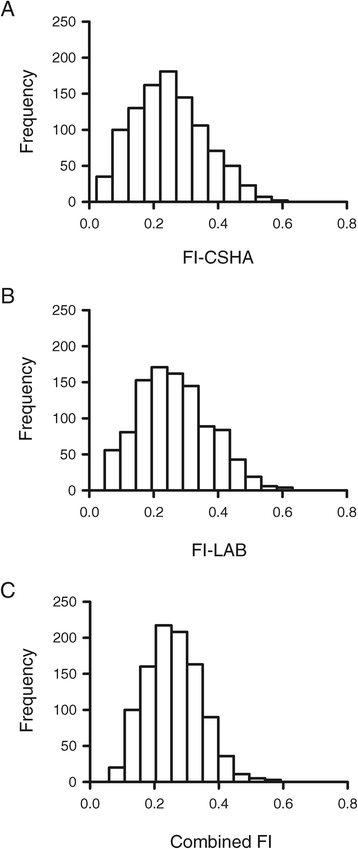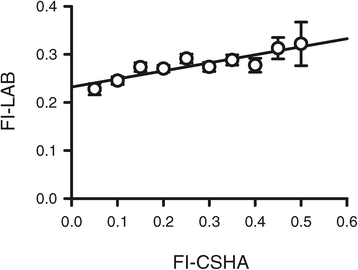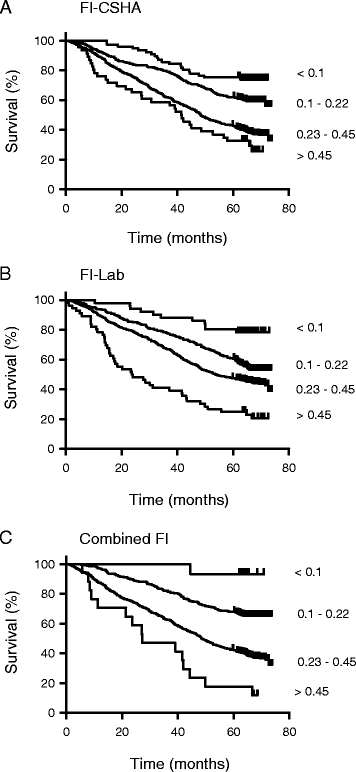Standard laboratory tests to identify older adults at increased risk of death
- PMID: 25288274
- PMCID: PMC4190374
- DOI: 10.1186/s12916-014-0171-9
Standard laboratory tests to identify older adults at increased risk of death
Abstract
Background: Older adults are at an increased risk of death, but not all people of the same age have the same risk. Many methods identify frail people (that is, those at increased risk) but these often require time-consuming interactions with health care providers. We evaluated whether standard laboratory tests on their own, or added to a clinical frailty index (FI), could improve identification of older adults at increased risk of death.
Methods: This is a secondary analysis of a prospective cohort study, where community dwelling and institutionalized participants in the Canadian Study of Health and Aging who also volunteered for blood collection (n = 1,013) were followed for up to six years. A standard FI (FI-CSHA) was constructed from data obtained during the clinical evaluation and a second, novel FI was constructed from laboratory data plus systolic and diastolic blood pressure measurements (FI-LAB). A combined FI included all items from each index. Predictive validity was tested using Cox proportional hazards analysis and discriminative ability by the area under receiver operating characteristic (ROC) curves.
Results: Of 1,013 participants, 51.3% had died by six years. The mean baseline value of the FI-LAB was 0.27 (standard deviation 0.11; range 0.05 to 0.63), the FI-CSHA was 0.25 (0.11; 0.02 to 0.72), and the combined FI was 0.26 (0.09; 0.06 to 0.59). In an age- and sex-adjusted model, with each increment in the FI-LAB, the hazard ratios increased by 2.8% (95% confidence interval 1.02 to 1.04). The hazard ratios for the FI-CSHA and the combined FI were 1.02 (1.01 to 1.03) and 1.04 (1.03 to 1.05), respectively. The FI-LAB and FI-CSHA remained independently associated with death in the face of the other. The areas under the ROC curves were 0.72 for FI-LAB, 0.73 for FI-CSHA and 0.74 for the combined FI.
Conclusions: An FI based on routine laboratory data can identify older adults at increased risk of death. Additional evaluation of this approach in clinical settings is warranted.
Figures



References
-
- Rodríguez-Mañas L, Féart C, Mann G, Viña J, Chatterji S, Chodzko-Zajko W, Gonzalez-Colaço Harmand M, Bergman H, Carcaillon L, Nicholson C, Scuteri A, Sinclair A, Pelaez M, Van der Cammen T, Beland F, Bickenbach J, Delamarche P, Ferrucci L, Fried LP, Gutiérrez-Robledo LM, Rockwood K, Rodríguez Artalejo F, Serviddio G, Vega E, FOD-CC group (Appendix 1) Searching for an operational definition of frailty: a Delphi method based consensus statement: the frailty operative definition-consensus conference project. J Gerontol A Biol Sci Med Sci. 2013;68:62–67. doi: 10.1093/gerona/gls119. - DOI - PMC - PubMed
Publication types
MeSH terms
Grants and funding
LinkOut - more resources
Full Text Sources
Other Literature Sources
Miscellaneous

